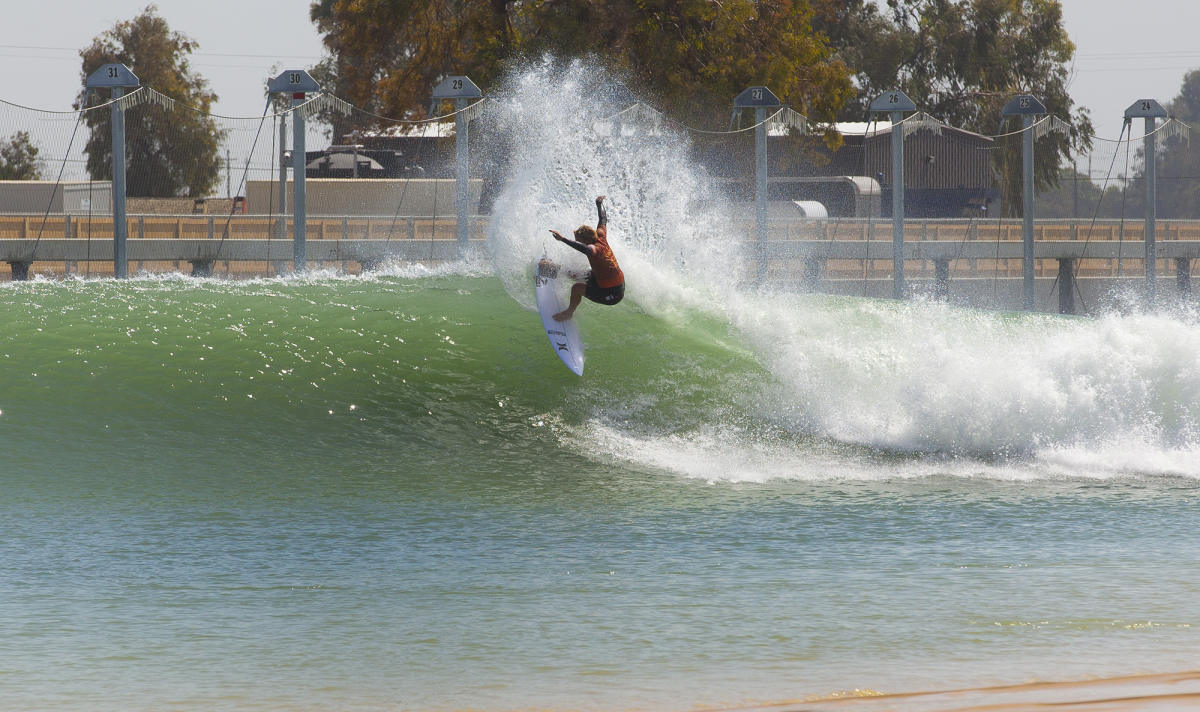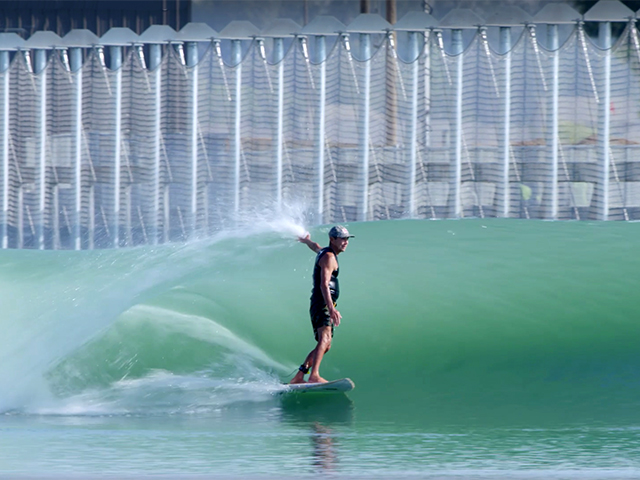Everything You Need To Know Before Surfing Kelly’s Wavepool
A comprehensive breakdown of the Surf Ranch.
In November of 2017, five members of the Stab team were invited to a Media Surf Day at Kelly Slater’s Wavepool in Lemoore, California.
You can read about that experience here, but for those slated to surf the pool soon, or if you’re simply curious about the logistics and tricks to riding this science, you’ll find all of those answers below*.
Getting there:
Lemoore, California—home of Kelly Slater’s Wavepool—is well and truly in the middle of nowhere. With no traffic, it’s roughly a three-hour drive from LAX, so you’ll want to cruise up the day before you surf. The route is simple: take the I-5 North up to Kettleman City, then hang a right onto Highway-41. If you’re coming from the north, you’ll take the I-5 South onto Highway-198. Both the 41 and 198 will take you almost all the way to your evening destination—The Tachi Palace and Casino.
Accommodation:
Besides the Wavepool, Lemoore has only one landmark you’ll need to be aware of, and that is Tachi Palace.
A sparkling oasis in the farmland, The Tach is where you’ll spend your night eating 1-star food, drinking (more than you ought to the night before realizing childhood dreams), and throwing away cash in the wonderfully grimy casino (smoking approved!).
Best of all, The Tach is less than five minutes from the pool.
The morning of:
Wake up early, and eat something light. As you get in your car, set the map to Kelly Slater Wave Co.—it’s a real, recognized destination! Upon getting cleared and entering the gates, you’ll make a quick left, and park in front of your favorite surfer’s plaque.
I chose Adriano de Souza, primarily because all the good spots were taken by early arrivals.
What do you need to bring?
Absolutely nothing, if you don’t want to. The place is stacked—50+ surfboards, a wide array of wetsuits, boxes and boxes of wax, sunscreen, and even Ibuprofen for when your hams get sore from 40-second rides.
Then again, there’s something to be said for the comfort and familiarity of one’s own gear, so feel free to bring as much or as little as you like.
Do you have to wear a leash?
Yes. And before you start complaining about how lame or stupid that rule may be, take it from someone who’s surfed the pool: you want to wear a legrope.
When you fall, your board is dragged along a semi-hard embankment, toward the shallow end of the pool, which is constructed of pure concrete. Even with a leash, this section has been known to rip out the odd fin or buckle a nose. But without one, it’s a foregone conclusion that your board will be destroyed.
How the groupings work:
Typically, wavepool staff split surfers into groups of five. This will be a crucial part of your experience, though you probably won’t realize until it’s too late.
To have the best possible pool experience (AKA to get the most waves) you’ll want your group comprising the worst possible surfers. The more they fall, the worse they paddle, the more you get to ride. You’ll understand why, below.
How the sessions work:
Every surfer gets two consecutive waves—first a right, then a left.
While Rider 1 is waiting for his first wave to arrive, Riders 2-5 will spread themselves evenly throughout the pool, sitting closely to the netting that separates pool and train. If at any point Rider 1 falls or gets stuck behind the section, whichever Rider is closest to the falling point can catch the wave and ride it as far as they’d like. If that Rider falls, the next guy picks it up and so forth.
During the five minute interval (!) between his two waves, Rider 1 will position himself at the far end of the pool to catch the left, and the process repeats itself. After the left, Rider 2 will get in position for the next right, and the series will continue until all Riders have had their turn.
Every group of five gets 50 minutes in the pool per session and two guaranteed rides.
Is it better to have one of the first or last Rider slots?
There are two commonly held theories, and on the Media Surf Day I was able to test them both.
Theory 1: If you’re scheduled at the back of the queue, you’ll have an opportunity to catch other people’s scraps and get a good warm-up for your “real” waves.
Theory 2: If you get your waves early, the pressure is off so you’re free to float whimsically about the pool, picking off waves hither and yon.
Implementing Theory 1 didn’t yield me any scraps, so I was left feeling agitated, anxious, and with very cold feet by the time it was my turn to surf.
Theory 2, however, got the monkey off my back and let me approach the rest of the session with a carefree attitude. I ended up catching 6 out of the 10 waves in that session.
That said, there’s no right or wrong answer here. Most of the time there’s one guy who happens to get lucky and pick off a lot of waves, and there are several people who get no scraps whatsoever. But if you can find a way to wrangle the opening wave of morning, I’d recommend you take it. It’ll be the cleanest, most pristine line you’ve ever laid eyes on — let alone ridden.
Nothing like it.
Understanding the Pole System:
If you look at a picture of the wavepool taken from land, you’ll notice a pier-like structure down the middle. This is where the wave-creating train runs its course. The pier is supported by metal pylons (or poles), which, though you can’t see this in most photos, are actually numbered. To surf the wavepool correctly, you’ll have to learn to read these numbers both before and while riding the wave (more on that in our “Reading the Sections” section).
The poles on the near-end of the pool (where the right is formed) start at #1, are roughly 12 feet apart, and run in numerical order all the way down to the other side. The number of poles climbs all the way to 100, which brings the total length of the pool to somewhere around 400 yards, though the wave is only rideable between Poles 12 and 88 — roughly a 300-yard stretch.

Know your Poles, know your sections. (Check the pole tops for their numbers.)
Photography
WSL
How the wave starts:
Before the wave arrives, a lifeguard in the tower will speak over the intercom with an ominous warning: One minute!
Exactly 50 seconds later, you’ll hear a sound not unlike the Smoke Monster from Lost, as the massive cable pulls the train along the track.
As the train gains speed, a small wake will start to form behind its leading edge. This lump will then grow from knee to waist-high, at which point it will start breaking. Which leads us to…
Where to take off:
The wavepool staff recommend newcomers catch their first right at around Pole 30. This is the friendliest take-off spot because at this point the wave has very little lateral speed, plus something of a chip-in entry.
If you’re feeling a bit cheeky, you can paddle as far up as Pole 20 — the pro takeoff zone — but beware of the long, crumbly section that comes down around Pole 25, which is known to catch even the quickest surfers off-guard. Once you get behind this wave, there’s no way to get back in front.
And really, the only advantage to taking off deep is one, crumbly, mediocre extra section.
Probably not worth it.
How to Catch the Wave:
Catching the wave isn’t necessarily difficult, but missing it would devastating.
So, when you see the line approaching, you’ll want to move 15 feet off the fencing and turn your back to the wave, while keeping an eye over your shoulder to position yourself — just like you would in the ocean.
As the wave reaches a distance of two pole-lengths away, start building some preliminary paddle speed, while peeking over your shoulder to determine the best point of entry. Guide yourself to that spot, and when the wave is about ten feet behind you, paddle your hardest at an angle that is 45-degrees away from the fence-line, to match the angle of the wave. If you do all of this correctly, you should catch it without problem.
How the wave fluctuates:
Would it absolutely shatter your world if I told you that not all waves in Kelly Slater’s wavepool are created equal?
Well, it’s true.
Across the 60 waves I saw break on our Media Surf Day, there were a few that behaved quite differently than expected.
Specifically, a few waves foamed-over where they shouldn’t have, leading to surfers getting clamped-on or stuck behind the section by no fault of their own.
Beyond that, some of the waves seem to break harder and faster, while others are more soft and slow.
Sometimes you pull the short stick.
Why the wave fluctuates:
One wavepool employee blamed the abnormalities on “misplaced” water.
What he means is this: When the wave breaks, the water gets pushed to the sides and far-end of the pool. As that energy refracts off the walls, it sends a smaller surge back in the other direction. This surge eventually reaches the other end of the pool and bounces back as an even smaller surge, and this process repeats itself until there is no energy remaining.
Now, where this invisible surge is located when they send the next wave determines how that wave will break—not unlike the effects of the tide.
If the surge is on the far-end of the pool when the next wave starts, the wave-face will be slightly steeper, due to the lack of the water below. If the surge is located in the same zone as the wave is breaking, it will soften due to the depth of the water.
This is one of very few variables that makes Kelly Slater’s wavepool a theoretically “imperfect” playing field.
Reading the sections:
Assuming you take off at Pole 30 (Left: Pole 70), you’ll have time for roughly two maneuvers before the wave starts to hollow out. Due to the wall’s lateral speed and the flimsiness of its lip, I wouldn’t recommend a full-wrapping maneuver nor a committed off-the-lip in that opening section — it’s just too much of a risk.
Rather, take this time to feel out the wave with some clean arcing maneuvers. And make sure you’re keeping an eye on the poles.
The first barrel section starts around Pole 45 (Left: Pole 55). This is the most user-friendly tube on the wave, and you’re going to want to capitalize.
In my experience, the easiest way to get inside is to stall in the pocket, then once the wave begins to hollow-out, use your back hand to pull the E-brake. When you get in the tube, stay small and trust the wave to hold its shape.
The pace of this section is such that you need to slow yourself down to stay inside. But don’t get greedy, you won’t have many chances.
Rocket science it ain’t.
That first barrel section will last anywhere between ten and fifteen seconds. Around Pole 60 (Left: Pole 40) the wave will start to slow-up, giving you an opportunity to escape the tube and open up on some turns. Because you’ve already achieved the primary goal, at this point the pressure should be off and you’ll be able to perform without fear of falling.
Go ahead and dig in, killer.
After two maneuvers here, you’ll have to prepare for the fastest, most difficult part of the wave.
The end section is beyond tricky. Without any familiar visual cues — not even as much as a bump or a boil — the wave will go hollow, stretch out, and run at twice the speed of any other section in the pool.
In order to make the final draining tube, you’ll have to convince yourself that despite what the wave is indicating (i.e. nothing), you need to get waaaay out on the shoulder by the time you’ve reached the second lifeguard tower, which is right around Pole 75 (Left: Pole 25).
Otherwise, as we learned all too well, you’ll get left in the dust.
Trust the ski drivers, not your instincts.
How to fall:
The pool is shallow and made of concrete. Unless you’re fan of cracked skulls or dislocated shoulders, you’ll want to fall flat and protect upper extremities. It’s just like surfing over shallow reef.
Where to sit when it’s not your turn:
While you’re guaranteed two waves per session, a truly great pool experience is built upon the others’ misfortune. In order to maximize your scavenging, position yourself in a prime location to pick up other’s scraps.
In my eyes, these are the two best spots to sit:
1. Pole 50 (Left: Pole 50): the middle of the first tube.
Many people will fall early on the ride, either due to overzealousness in their turns or an inability to ride the tube. Be ready pounce when this happens, but please, please do not snowball someone.
In the ocean it’s uncouth, in a pool it’s downright egregious.
In other words, please refrain from “Scott Bass-ing” your friends.
2. Pole 69 (Left: Pole 31): just before the second tube section.
After a 10-second pit (or head-dip, whatever), Riders emerge from the first section feeling quite, um, full of themselves.
The residual adrenaline will prime them to go all-out on the wave’s middle section, making them liable to take a dive.
If and when that happens, you’ll be positioned to capitalize on that dreamy inside bowl.
Unspoken rule: When you get a scrap, please don’t surf it like a coward. If you’re gonna take someone’s sloppy-seconds, you might as well give it all you’ve got.
Can you pee in the pool?
Presumably frowned upon, but I don’t see why not.
Lefts vs. rights:
Due to local winds and perhaps some underwater hydrodynamic principles I’ve failed to comprehend, the Right is generally a taller, hollower wave than the Left.
When tradewinds blow hard from the Northwest, the Left becomes noticeably smaller and hardly barrels at all.
With dead winds, the waves are more or less the same size, but the Right still seems to throw a bit harder.

Though, you don’t HAVE to get barreled to have a good time.
Photography
KS Wave Co.
Wave Difficulty Levels (CT-1 vs. CT-2):
Kelly Slater’s wavepool is designed in a way that allows the control center to alter certain aspects of the wave to account for riders of different ability levels.
At our Media Surf Day, we witnessed two different levels: CT-1 and CT-2.
The main difference is that CT-1 is a faster and steeper wave than CT-2. In the CT-2 barrel, you’ll be able to easily control and maneuver your board in the tube. In CT-1, because of how cupped-out the section gets, you’ll have to sit on your back just to keep the nose up. It’s also a little harder to do full turns on CT-1 because of the lateral speed it carries throughout the ride.
Experts should try CT-1, but intermediate surfers will have much more fun on CT-2.
Coming Down:
Surfing this wave induces a dopaminergic surge, and for that same reason it’s known to cause a highly depressive funk in the days following a pool session.
Knowing that you’re unlikely to surf a wave of similar quality, real or manmade, in the next however many months can be a hard pill to swallow. Unless you luck immediately into a pumping organic ocean swell, surfing over the next days, weeks, or months can be a depressing affair.
The only advice I can give is to think of the Pool as a treat — something to be enjoyed in small, infrequent doses, because ingesting too much might cause you to rot from the inside out.
While the full psychological effects of wavepool surfing have yet to be studied, perhaps this nugget from Matt Warshaw, recorded two weeks after our Media Surf Day, will help you understand the severity of the Post-Pool situation.
“I really think I could do heroin and walk away from it, but not the pool,” Warshaw told me. “I think about it every day.”
*Disclaimer: Shortly after our Media Surf Day, the WSL shut the Lemoore pool (which they’ve always considered their Ground-Zero, R&D site) down for three months so they could make alterations. Because we’re yet to see the revamped design, it’s possible some of the above observations are no longer relevant to the pool’s current and/or future models.





Comments
Comments are a Stab Premium feature. Gotta join to talk shop.
Already a member? Sign In
Want to join? Sign Up